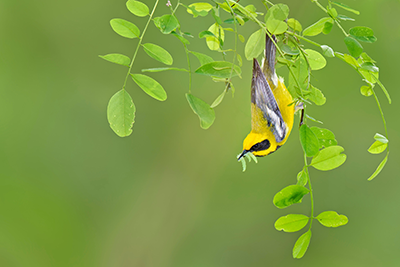By Marcella D. Baiz and David P.L. Toews
Linked paper: Genomic and plumage variation in Vermivora hybrids by Marcella D. Baiz, Gunnar R. Kramer, Henry M. Streby, Scott A. Taylor, Irby J. Lovette, David P. L. Toews, The Auk: Ornithological Advances
Wood warblers are among the most diverse and colorful songbirds in the Americas. Many of the more than 100 species can interbreed and produce hybrid offspring that look very different from their parents. In a recent study, we used whole-genome sequencing to examine inheritance of plumage characters in hybrids between two Vermivora warbler species. We wanted to determine whether certain hybrids could be identified by the degree of yellow carotenoids in their plumage, and better resolve genomic regions that control plumage color.
In North America, hybrids of Blue-winged and Golden-winged warblers have a mixture of plumage characteristics from each species. Because they look so distinct from their parents, two of the hybrid plumage types were once thought to be separate species.
Originally named “Lawrence’s” warblers, this hybrid type resembles Blue-winged warblers, but they have the distinctive black face mask and black throat patch that is unique to Golden-winged warblers. Similarly, “Brewster’s” warbler hybrids have many features that resemble Golden-winged warblers, but lack their unique black face mask and black throat patch. It is hypothesized that Brewster’s are first-generation (F1) offspring, owing to the fact that they are much more abundant than Lawrence’s.
Brewster’s warblers were originally given the species name leucobronchialis, meaning “white throat.” This likely contributed to an early consensus that F1s should also have white underparts, a view still popular among contemporary birders. However, there is significant color variation among Brewster’s hybrids. In 1951, Kenneth Parkes noted:
“… mention is usually made of the variation in the color of the underparts, as a large proportion of the individuals, instead of being immaculately white beneath, are quite yellowish. Usually this ‘variation’ is dismissed by calling such birds ‘individual variants’, ‘intermediates’ …”
Parkes wanted to understand the mechanism of inheritance behind this variation. He hypothesized that if underparts color is determined by one gene, the allele for white is incompletely dominant over the allele for yellow. This means that early-generation hybrids would actually be partially yellow (receiving a yellow allele from its Blue-winged parent, and a white allele from its Golden-winged parent), and Brewster’s with white underparts would instead be observed in later generations as a result from backcrossing.
To get at the question of the coloration of early-versus-late generation hybrids, we had an advantage over Parkes—we could use our genomic data to directly determine the ancestry of hybrids. Moreover, although Golden- and Blue-winged warblers look strikingly different, their genomes only differ in six small regions. Therefore, we used DNA sequence in those six regions to classify ancestry in hybrids and test for associations with plumage.
We quantified genomic variation in hybrids to classify their ancestry, as a kind of “hybrid index score.” Consistent with expectations, we found that the Lawrence’s genome closely resembled Blue-winged warblers (except for one small region—see below), whereas the Brewster’s hybrids fell along a broader spectrum between the two parental species.
While our sampling did not appear to include a clear first-generation hybrid, if yellow coloration was controlled by a single gene, or even several that had a cumulative effect, we would expect a signature of this in our data. We found no clear relationship between yellow coloration and hybrid index, suggesting this plumage trait is complex, and the variation seems generally consistent with Parkes’ interpretation of the patterns over 50 years ago.
But to further complicate the story, when we studied photos of hybrids captured across multiple years, we noted something surprising: the yellow in their feathers declined over time—dramatically in some cases—suggesting an effect of age and/or diet. This was unexpected since this kind of interannual changes in plumage coloration had never been observed before in adult Vermivora warblers. While this finding was opportunistic based on a small number of recaptured hybrids, we want to investigate this in more individuals, since it may help us understand the mechanisms underlying this trait. But for now, the genetic basis and inheritance of yellow pigmentation in Vermivora remains somewhat elusive.
Thankfully, the genetics of throat coloration is much more straightforward. A previous study linked the presence/absence of the black throat patch to a region near the Agouti Signaling Protein (ASIP) gene, which regulates the amount of black (melanin) pigmentation in several species.
We used the genome of the Lawrence’s warbler to our advantage to determine if we could narrow the causal region responsible for the throat patch. This was possible because the Lawrence’s warbler has a genome that nearly completely resembles the Blue-winged warbler, yet it has the black throat of the Golden-winged warbler—and consequently, the genomic region that underlies the black throat phenotype. We quantified transitions from Blue-to-Golden-winged ancestry in the Lawrence’s warbler genome near the ASIP gene. The only region of golden-wing ancestry in the entire Lawrence’s warbler genome occurs upstream of ASIP, and is five times smaller than the previously defined region. Therefore, this single hybrid helped us narrow the ‘switch’ that likely turns on or off the black throat phenotype.
This work is part of our team’s effort to study warbler diversification and the evolution of coloration. We have already begun to identify similarities between species in differentiation at plumage genes, including ASIP, between other, closely related Setophaga warblers. We are excited to continue sequencing warbler genomes so we can extend our research across the whole family.
